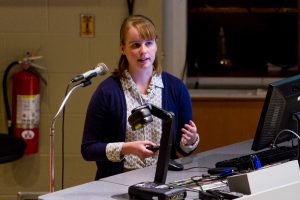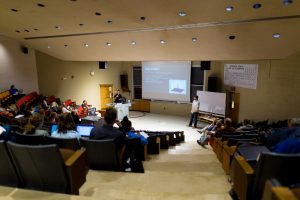Twelve students representing eight research projects across various scientific disciplines had to condense and disseminate their results of weeks or semesters of work at Eastern Mennonite University’s Dec. 7 STEM Student Research Symposium.
“It forces you to rethink your project,” says biology professor and judge Eva Pastalkova. Efficiently clarifying specialized research is a valuable process, explained Pastalkova, who came to EMU after seven years leading an independent lab at Janelia Research Campus.

This clarity is invaluable when researchers have less than ten minutes to introduce audiences to, for example, the upregulation of the nuclear factor of activated T-cells 5, arylation of phenanthroline, or changes in the gene expression of intestinal alkaline phosphatase.
For the scientifically uninitiated, humorous anecdotes and the intrusion of mechanical failures gave context to the technical terminology.
“Here is a mugshot of the main villain of this story: the melon fly,” said Diego Barahona, a senior biochemistry major.
“We don’t think the cobalt played along at all,” joked another senior biochemistry major, Eli Wenger, about his inorganic nanochemistry work.
Wenger, who placed third in the event, shared the results of a summer research placement at Penn State University in the National Science Foundation Research Experience for Undergraduates (REU) program.
First and second place awards were also made to recent REU participants: senior Janaya Sachs for her chemistry project and junior Amanda Williams, a biology and environmental sustainability major, for her bio-remediation project in Delaware.
(Read more about all research projects and presenters below.)
The presenters were evaluated based on two criteria: clear statement of the problem, including what they’re investigating and why; and clear presentation of their process, findings and its relevance.
Research challenges

Staying focused in the face of failure was a challenge for many student researchers. Marcy Smucker dealt with a broken PCR machine rendering half of her data unreadable. She and Taylor Esau had to rework their analysis methods, said Smucker.
Others found that their months of effort created more questions than they answered. As part of a larger research team, Braden Herman and Sammy Kauffman tracked genetic changes in rats as the result of high salt and fructose diets. (Smucker will join them next semester, under Professor Julia Halterman, as they investigate other gene expressions in a wider variety of bodily tissues, with the hopes of identifying markers for the risk of heart attacks and strokes.)
One project may have immediate and lucrative application: David Nester and Kyle Johnson worked on image-tracking software they hope to market to physics laboratories by the end of next semester.
“Setting up objectives and goals and then making the short-term decisions to reach them is not something that you normally experience in a regular class,” says Nester. “This project has given me that experience.”
STEM Research Symposium Awards
- First place: Janaya Sachs, senior chemistry major: Exploration into Ligand Synthesis using Photochemistry and the Effectiveness of Copper Photocatalysts. Sachs worked on this project through the REU program in Budapest, Hungary. Her green chemistry work attempted to create more affordable materials for photocatalytic processes.
- Second place: Amanda Williams, junior biology and environmental sustainability major: Effects of Bio-Remediation on Zooplankton in South Bethany (DE) Canals. Also part of the REU program, Williams worked with the Delaware Center for Inland Bays to test water quality and biodiversity before and after bio-remediation attempts in polluted canals.
- Third place: Eli Wenger, senior biochemistry major: Investigating Cation Exchange with Copper Nitride and Copper Palladium Nitride to Access Other Colloidal Nitrides. Wenger joined the Schaak laboratory at Pennsylvania State University under the REU program, using synthetic inorganic nanochemistry in an attempt to create metal catalysts for water-splitting reactions more readily available than those used today.
- Honorable mention: Kat Lehman, Hannah Walker, junior biochemistry majors: Analysis of Volatile Profiles for Coffee Damaged by the Coffee Berry Borer (Hypothenemus hampei). Lehman and Walker traveled to the Kona region of Hawai’i to study the chemical profiles of coffee pest-damaged coffee compared to those of intact beans.
- Braden Herman, Sammy Kauffman, junior biology and pre-med majors: Expression of NFAT-5 in Rat Tissues Under Varying Salt and Fructose Diets. Herman, Kauffman and their team analyzed a specific gene expression in the kidneys, liver, pancreas, and stomach of rats as it reacted to diets associated with hypertension and metabolic disorder in humans.
- Kyle Johnson, senior computer science major, David Nester, senior computer science and mathematics major: Object Tracking in Video for Physics Labs. Johnson and Nester developed software to analyze slow-motion videos of projectiles, collisions and trajectories to assist physics research.
- Taylor Esau, Marcy Smucker, junior biochemistry majors: The Effects of Antibiotics/Corn Oil on Mice ALPI Gene Expression. Esau and Smucker tested mouse droppings and tissues to track Alkaline phosphatase expression in the intestinal tract in response to high fat diets and antibiotic intake. The expression indicates the body’s attempt to regulate the production of endotoxins that can cause problems such as Type 2 Diabetes in humans.
- Diego Barahona, senior biochemistry major: Syntheses and Behavioral Evaluation of Analogs of Raspberry Ketone as Attractants for the Melon Fly, Zeugodacus cucurbitae. Barahona traveled to Hawai’i to work on superior pheromone traps for a melon-destroying pest by chemically altering the structure of a known attractant to make it more appealing to the fly.
Read more on undergraduate research opportunities
- Coverage of summer 2016 Research for Undergrad (REU) experiences
- Coverage of fall 2015 research symposium;
- Coverage of spring 2015 and spring 2016 poster sessions;
- Visit webpages on research conducted by professors in biology, chemistry, and environmental sustainability.

